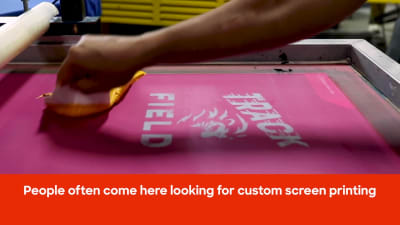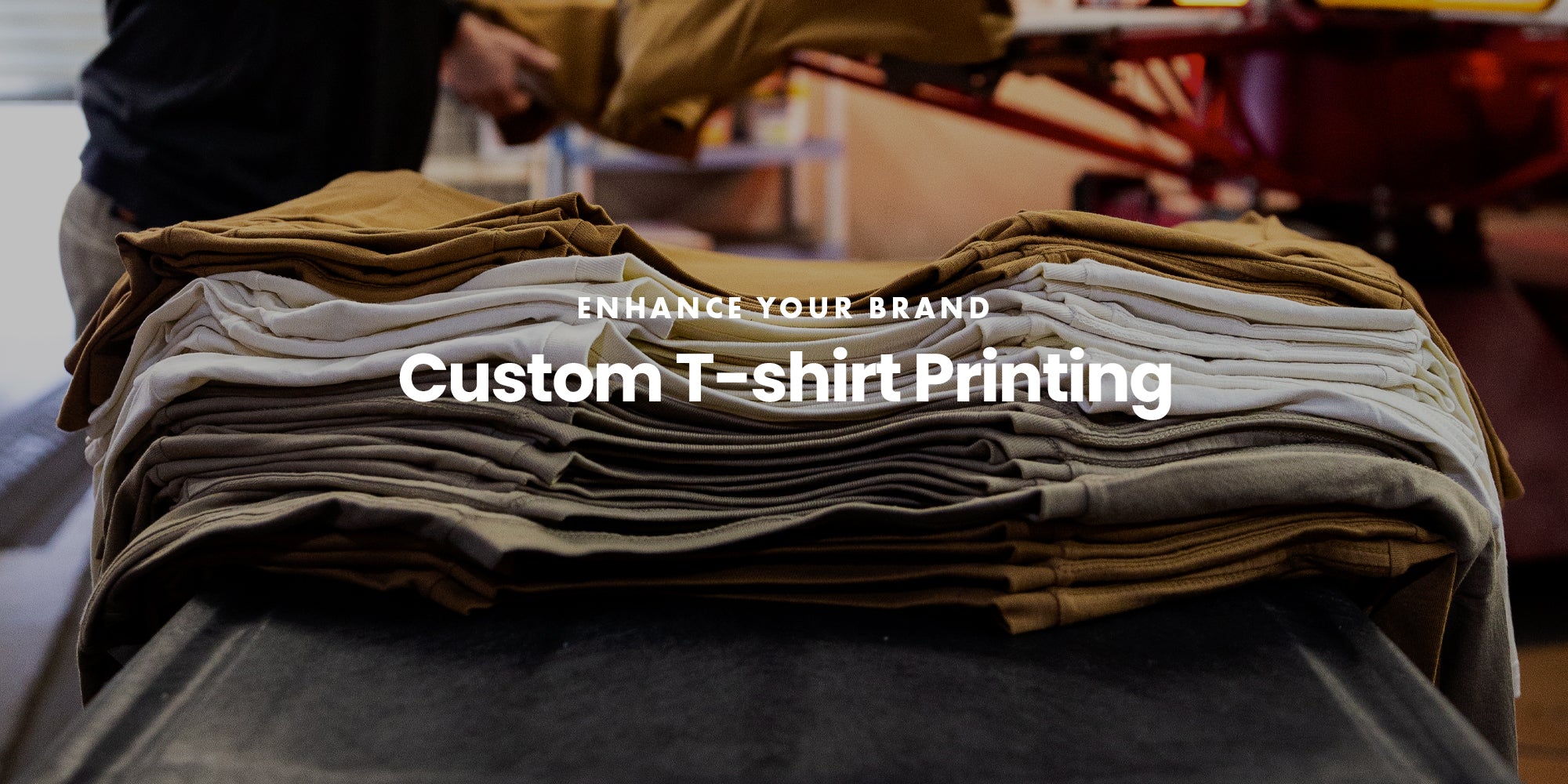Display Printing Uncovered: Everything You Required to Find Out About Tee and Garment Printing Techniques
Screen printing is a fascinating method that combines art with strategy, supplying countless opportunities for imagination. Ready to explore the important elements that make display printing an art kind?
The Fundamentals of Display Printing: How It Functions
When you plunge right into screen printing, you'll uncover it's both an art and a scientific research. At its core, screen printing entails producing a stencil, or screen, that permits ink to go through only in specific locations (screen printing kit). You begin by choosing your layout and preparing your screen with a light-sensitive solution. Once you reveal this emulsion to light, it hardens, leaving your style as an unfavorable space.
Setting the display over the textile, then make use of a squeegee to press ink through the screen onto the garment. Each action is crucial, and mastering them will certainly raise your screen printing abilities, changing straightforward garments into distinct, expressive pieces.
Sorts Of Screen Printing Techniques
As soon as you realize the essentials of display printing, it's time to explore the various strategies that can boost your styles. One prominent method is typical display printing, where ink is pushed via a stenciled display.
An additional option is plastisol printing, understood for its toughness and vibrant shades, making it a preferred for lots of brands. Experiment with halftone printing to create gradient results and complex layouts.
Crucial Devices for Display Printing
To accomplish sensational cause display printing, having the right devices is essential. You'll require a durable display printing structure, which holds the mesh that transfers your layout onto the garment. Next, spend in high-grade mops; these are important for using ink evenly throughout the screen. You'll likewise call for a good exposure device to create your displays, along with a washout booth for cleaning them after usage. A dependable warmth source, like a conveyor clothes dryer or warmth press, is essential for curing your prints to ensure long life. Do not fail to remember a proper office, outfitted with tables and storage for your materials. Ultimately, protective gear, such as handwear covers and masks, will certainly keep you secure from chemicals and inks. With the right tools, you'll be well on your means to creating professional-quality prints.
Selecting the Right Inks and Materials
When choosing inks and materials for screen printing, you need to take into account the sort of ink that works best for your project. Consider fabric compatibility to assure your designs look last and wonderful long. Check out eco-friendly ink choices to make your printing procedure more sustainable.
Kinds Of Display Inks
Selecting the best screen ink is necessary for attaining lively, sturdy prints that satisfy your project's requirements. There are a number of sorts of display inks to analyze. Plastisol ink is popular for its versatility and simplicity of usage, providing superb shade opacity on dark fabrics. Water-based ink, on the various other hand, supplies a softer feel and is environment-friendly, making it optimal for those looking to minimize their ecological impact. Release inks eliminate color from the material, causing a soft, vintage appearance but call for certain handling. Specialty inks, such as metal or glow-in-the-dark, can add unique effects to your layouts. Assess your task requirements and pick the ink that aligns ideal with your preferred outcome.

Textile Compatibility Factors To Consider
Recognizing material compatibility is vital for achieving premium screen prints, specifically considering that different products react distinctly to different inks. Always test your inks on sample material to guarantee they stick effectively and preserve shade honesty. In addition, keep in mind that material weight and texture can impact the last end result, so picking the best ink and product combo is important for your project's success.
Eco-Friendly Ink Options
Green inks are ending up being a prominent option for display printers that desire to decrease their ecological influence while maintaining high quality. When picking inks, consider water-based inks, which are less damaging and much easier to clean up compared to standard solvents.
In addition, seek inks made from eco-friendly sources, such as soy or vegetable-based alternatives. By picking the appropriate inks and products, you'll not just create sensational styles however likewise add to a more sustainable printing process. Make the button, and your prints will certainly reflect your commitment to the environment!
Preparing Your Design for Display Printing

File Format Needs
To guarantee your style looks sharp and dynamic on textile, you'll need to pay close focus to file style needs for display printing. Begin with vector files like AI or EPS, as they can be scaled without shedding quality. If you use raster photos, opt for high-resolution documents, such as TIFF or PNG, preferably at 300 DPI. Avoid making use of JPEGs, as they can lose clearness when resized. Make sure your design has a clear background to avoid undesirable white sides on your prints. Maintain shade settings in mind; CMYK is common for screen printing, so convert your RGB makes accordingly - screen printing kit. By complying with these standards, you'll set your artwork up for an effective print.
Color Separation Techniques
Shade splitting up is a crucial step in preparing your layout for screen printing, and grasping it can considerably enhance your print quality. You'll require to damage your layout into individual shades, as each color calls for a separate display during printing. This precision not just guarantees exact color depiction but additionally simplifies the printing process.
Resolution and Dimension
Accomplishing the most effective lead to screen printing begins with guaranteeing your style has the right resolution and dimension. Ideally, your art work should be at the very least 300 DPI (dots per inch) for sharp, clear prints. Your final item might look amateur and pixelated. if you utilize lower resolution.
When it pertains to dimension, consider the dimensions of your print location. Design your artwork to match the last print dimension, ideally developing it in the actual dimensions you'll be publishing. By doing this, you'll avoid any unforeseen scaling concerns.
Always check your style in both vector and raster layouts. Vector graphics can be scaled without losing view it now top quality, making them optimal for display printing. Preparing appropriately will assure your design looks incredible on every garment!
Step-by-Step Screen Printing Process
Screen printing is a dynamic procedure that permits you to develop dynamic styles on different surfaces. To start, you'll need a screen, emulsion, and your selected ink. Initially, prepare your display by cleansing it completely. Next, use the solution equally and allow it dry in a dark area. Once dry, expose your screen to light with your layout positioned on it, which will certainly set the solution where the light hits, producing a pattern - screen printing kit.
Pour ink onto the display and utilize a squeegee to push the ink via the stencil onto the fabric. Lift the display thoroughly and allow the print completely dry. You've efficiently screen published your style.
Tips for Successful Display Printing Projects
While you're diving right into your screen printing tasks, bear in mind that preparation is crucial to success. Begin by gathering all your products-- inks, screens, mops, and garments. A clean office helps stop unwanted errors, so clean up before you begin.
Following, confirm your artwork is high-resolution and properly sized for your garment. Check your screen for appropriate exposure and tidy it completely to stay clear of smudges. When blending your inks, comply with the producer's standards to attain the ideal uniformity.
During printing, use even stress with your squeegee for consistent outcomes. Do not hurry; take your time to confirm each print fulfills your standards. After printing, allow your garments completely dry totally before managing or packaging them.
Lastly, always keep an example of your work for future recommendation. By doing this, you can analyze your progress and boost your strategies over time. Happy printing!

Often Asked Questions
How much time Does It Take to Set up a Screen Printing Work?
Establishing a display printing job normally takes around half an hour to an hour. You'll prepare the screens, mix inks, and change journalism. The moment varies based on complexity and experience, so remain arranged!
Can I Print on Different Material Types Using the Very Same Method?
Yes, you can print on different textile kinds making use of the same technique, yet you'll require to change your inks and setups. Some fabrics take in ink in a different way, so exploring assurances the best outcomes for each material.
What Prevail Errors to Avoid in Display Printing?
When screen printing, stay clear of typical mistakes like making use of the wrong ink, overlooking appropriate exposure times, or missing pre-press checks. Constantly test your arrangement and preserve clean screens to ensure quality outcomes each time.
How Can I Appropriately Tidy and Maintain My Display Printing Equipment?
To effectively clean and keep your screen printing tools, you ought to consistently wash screens with appropriate solvents, inspect mops for wear, and guarantee all devices are stored dry and dust-free. Consistency stops costly repair services and enhances efficiency.
Is Screen Printing Eco-friendly Compared to Other Methods?
Screen printing can be much more eco-friendly than various other approaches, particularly if you use eco-conscious materials and water-based inks. By selecting lasting supplies and methods, you reduce waste and lessen your impact on the planet.
Screen Printing Uncovered: Every Little Thing You Required to Know Concerning T-Shirt and Garment Printing Techniques
At its core, display printing entails developing a stencil, or display, that permits ink to pass with only in specific areas. Placement the display over the fabric, after that use a squeegee to press ink with the display onto the garment. One popular technique is conventional display printing, where ink is pushed via a stenciled display.When picking inks and products for display printing, you require to take right into account the type of ink that functions special info ideal for your task.